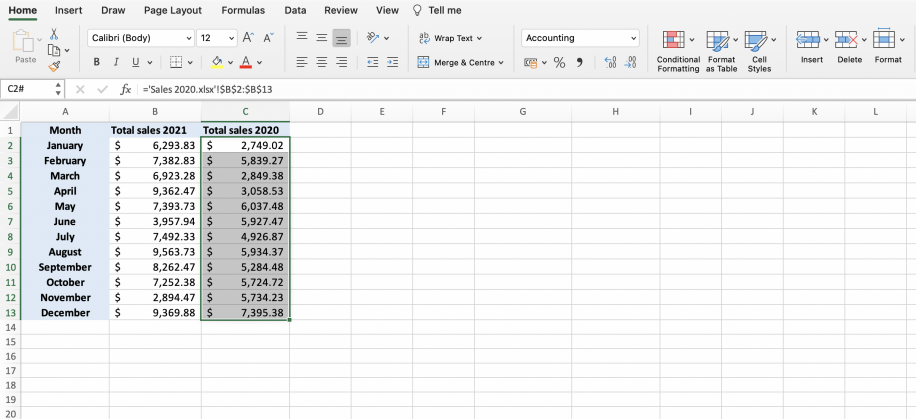Excel: Reference Columns from Other Sheets Easily

When it comes to working with Microsoft Excel, understanding how to reference columns from other sheets is essential for anyone looking to enhance their spreadsheet skills. Whether you're managing financial data, inventory, or any other large dataset, being able to link information across multiple sheets can significantly improve your workflow efficiency. Here's how you can master this skill:
Understanding Excel Sheet Navigation

Before diving into referencing columns from other sheets, let’s briefly touch on how to navigate between sheets:
- Click on the sheet tab at the bottom of the Excel window to switch between sheets.
- Right-click on a sheet tab for options to rename, move, copy, or insert new sheets.
- Use keyboard shortcuts like Ctrl+Page Up/Page Down (Windows) or Option+Left/Right (Mac) to cycle through sheets.
How to Reference a Column from Another Sheet


Now, let’s look at how to reference columns from other sheets:
Basic Sheet and Cell Referencing

To reference a column from another sheet, you’ll use the following syntax:
‘SheetName’!ColumnReferenceHere’s a step-by-step guide:
- Click into the cell where you want the referenced data to appear.
- Type the equal sign (=) to begin the formula.
- Type or click on the sheet name followed by an exclamation mark (!).
- Finally, input the column reference. For instance, if you want to reference column A from Sheet2, you would type:
=Sheet2!A:A⚠️ Note: Be aware that dragging the fill handle down will replicate the formula for each row in the column unless you use the $ to lock the column reference (absolute reference).
Using Functions with Referenced Columns

Referencing columns from other sheets can be combined with Excel functions to perform complex data operations:
- SUM: Add up values from a column in another sheet:
=SUM(Sheet2!A:A)=AVERAGE(Sheet2!B:B)=VLOOKUP(A2, Sheet3!A:D, 2, FALSE)Working with Named Ranges

Another powerful method to reference columns from other sheets is by using named ranges:
- Select the column in the source sheet you want to name.
- Go to Formulas > Define Name.
- Enter a name for the range (e.g., ‘SalesData’).
- To reference this named range from another sheet:
’=SalesDataPotential Pitfalls and Best Practices

Here are some tips to ensure your column references work smoothly:
- Be Mindful of Sheet Names: Changing a sheet’s name will break existing references. Always update the references if you rename a sheet.
- Watch for Circular References: A cell referencing itself or another cell that ultimately references back to itself can cause Excel to loop indefinitely.
- Use References Judiciously: Excessive cross-referencing can make your workbook complex and slow. Keep it organized.
💡 Note: Consider using 3D references for summarizing data across multiple sheets efficiently.
Table Reference Example

| Sheet Name | Column Reference | Formula Example |
|---|---|---|
| Sheet2 | Column A | =Sheet2!A:A |
| Inventory | Columns B:D | =SUM(Inventory!B:D) |
| Sales Data | Column J | =COUNT(SalesData!J:J) |

Advanced Techniques

For power users, Excel offers advanced referencing capabilities:
Linking with External Workbooks

You can also reference columns from other Excel workbooks:
=‘C:\Path[ExternalWorkbook.xlsx]Sheet1’!ColumnReference🚫 Note: External references can create dependency issues if the referenced workbook is moved or renamed.
Dynamic Sheet References

By utilizing Excel functions like INDIRECT, you can create references that change dynamically:
=INDIRECT(“‘Sheet”&A1&“’!B:B”)Where A1 contains the sheet number, allowing you to switch sheets dynamically.
As we've explored, referencing columns from other sheets in Excel is a straightforward process, but it comes with its own set of best practices and potential pitfalls. By understanding how to navigate sheets, use basic and advanced referencing techniques, and manage potential issues, you can harness the full power of Excel to streamline your data management tasks. Whether you're compiling data for financial reports, creating dashboards, or simply organizing personal budgets, these skills will enable you to work more efficiently and accurately. Remember to keep your references organized, update them when necessary, and avoid circular references to keep your workbooks running smoothly. With these practices in place, you'll find yourself managing complex datasets with ease, saving both time and effort in the process.
What happens if I change the name of a sheet with references?

+
If you rename a sheet, any formulas referencing that sheet will break, displaying a #REF! error. You must update the formulas to reflect the new sheet name.
How do I reference a column from another workbook?

+
Use the full path or ensure both workbooks are open. For example: =‘C:\Path[ExternalWorkbook.xlsx]Sheet1’!ColumnReference
Can I reference multiple sheets at once?

+
Yes, by using 3D references or functions like SUMIF or VLOOKUP across multiple sheets, although it can become complex for large datasets.



